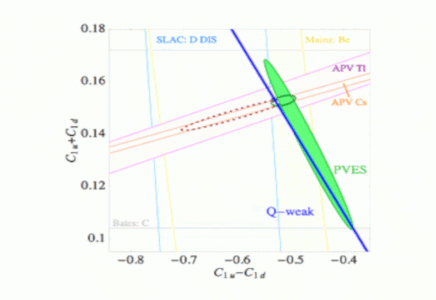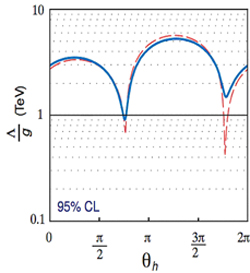Precision Test of the Standard Model

Figure 1 shows the knowledge of the weak charges associated with an axial coupling to the electron and a vector coupling to the up and down quarks. All experimental limits and contours are shown at 1 standard deviation. The dashed contour displays the previous experimental limits reported by the Particle Data Group, together with the prediction of the Standard Model (the black star). The filled ellipse denotes the new constraint provided by recent high precision PVES measurements on p, D and He, while the smaller contour indicates the full constraint obtained by combining all current results. The width of the solid blue line is the anticipated uncertainty of the upcoming Qweak experiment - assuming the SM.
Additional Links
The Electroweak Standard Model (SM) has to date been enormously successful. The search for a fundamental description of nature which goes beyond the SM is driven by two complementary experimental strategies. The first is to build increasingly energetic colliders, such as the Large Hadron Collider (LHC) at CERN, to excite matter into a new form.

Figure 2 shows the model independent mass limit (Λ/g) in TeV of new physics as a function of the up and down quark flavor mixing angle, theta. The dashed red curve is the Particle Data Group limit, while the solid blue curve is the improvement from including recent PVES measurements.
The second approach is to perform high precision measurements where an observed discrepancy with the SM would reveal the signature of new forms of matter. As shown in Figure 1, state-of-the-art measurements of parity-violating electron scattering (PVES) at Jefferson Lab have led to the most precise determination of the weak charges of the quarks hitherto possible. Shown in Figure 2, these measurements also constrain the possibility of new physics to an energy scale of order one TeV or higher — a factor of two above previous limits, which were dominated by atomic parity violation (APV) data. While limiting the early discovery potential for new Z' bosons, this result provides guidance as to the best windows of opportunity for discovery, both at the LHC and in the Qweak experiment now in preparation at Jefferson Lab.
References:
R. D. Young, R. D. Carlini, A. W. Thomas and J. Roche, Phys. Rev. Lett. 99 (2007) 122003
R.D. Young et al. Phys. Rev. Lett. 97 (2006) 102002
D. S. Armstrong et al. (G0 Collaboration), Phys. Rev. Lett. 95 (2005) 092001
A. Acha et al. (HAPPEX Collaboration), Phys. Rev. Lett. 98 (2007) 032301

